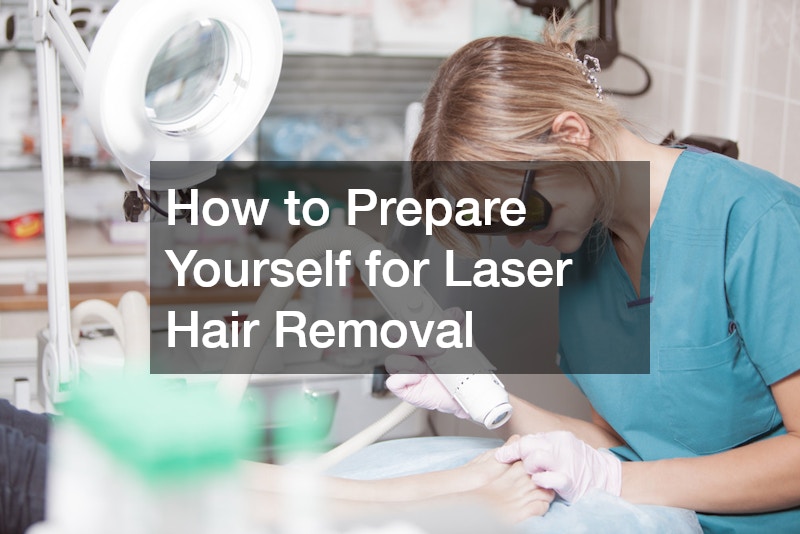
Laser hair removal has become a popular method for achieving long-lasting hair reduction. However, proper preparation is essential for ensuring both effective and safe treatment outcomes. This article will guide you through the necessary preparations, addressing common concerns and questions asked by individuals considering this procedure.
Is Laser Hair Removal Right for Your Skin Type?
Understanding Skin Tones and Laser Compatibility
Laser hair removal technology interacts differently with various skin tones. The effectiveness of the procedure largely depends on how well the melanin in the skin absorbs the laser.
Individuals with lighter skin and darker hair typically see the best results, but advancements in technology are broadening the applicability for other skin tones.
Modern lasers, like the Nd:YAG laser, are designed to better accommodate darker skin tones. However, it’s crucial to understand that certain risks such as hyperpigmentation exist if the laser is not appropriately chosen or applied. Therefore, understanding your specific skin type can help in choosing the right technology and settings for optimal outcomes.
When considering laser hair removal, it’s important to acknowledge that results vary based on skin tone and hair color. Research shows that matching the type of laser to your skin type can minimize side effects while maximizing effectiveness. Make sure your provider has experience in dealing with your particular skin type for the procedure.
Consultation with a Specialist
A consultation with a qualified specialist helps determine if laser hair removal is the right choice for you. During this meeting, the specialist will assess your skin type and hair characteristics to recommend an appropriate treatment plan. This initial evaluation is also an opportunity to ask questions and understand the benefits and limitations of the procedure.
Consultations help dispel any myths or misinformation you might have encountered about laser hair removal. Specialists can explain the science behind how lasers work and what technologies are available for different skin types. This tailored advice aids in setting realistic expectations for the results you can expect to achieve.
Your consultation is also a time to determine the cost and number of sessions required for satisfactory results. Specialists are equipped to provide guidance on financial aspects, as well as offer advice on pre- and post-treatment care. Understanding all aspects of the journey can help ensure a smoother process and higher satisfaction with the results.
Patch Test Procedures
A patch test is a standard procedure used to assess your skin’s reaction to laser treatment. Conducted on a small area, this test helps determine the laser settings suited for your skin type and tone. The results can minimize any potential risk of adverse reactions during full treatments.
The patch test typically takes place during the initial consultation or before starting the treatment series. Specialists carefully monitor the tested area for any side effects, such as redness or irritation, over a set period. This information provides valuable insights into how your skin might respond to the procedure overall.
Performing a patch test does more than just check for adverse reactions; it plays a role in optimizing treatment settings. Customizing the laser configuration based on patch test results enhances both safety and efficacy of the treatment. Always ensure that a patch test is part of your consultation process to safeguard your skin’s health.
How Should You Prepare Your Skin Before the Procedure?
Avoiding Sun Exposure and Tanning
Avoiding sun exposure is one of the most critical steps in preparing for laser hair removal. Tanned skin can interfere with the laser’s ability to target hair follicles effectively, thereby reducing the procedure’s effectiveness. At least two weeks before and after treatment, it is recommended to limit sun exposure and use high-SPF sunscreen.
Prolonged sun exposure increases the risk of complications, such as hyperpigmentation or skin burns. Consulting with your specialist about the best practices for sun protection can provide additional safety. Wearing protective clothing and using sunblock are key preventive measures to preserve your skin’s health during this period.
Adequate planning to avoid tanning can optimize the safety and results of your laser hair removal. The natural pigmentation of untanned skin allows for better laser targeting and efficiency. Taking these precautions supports a smoother and more effective treatment experience.
Shaving the Treatment Area
Shaving the treatment area is a critical step before undergoing laser hair removal. It ensures that the laser energy is focused on the hair follicle beneath the skin’s surface, where it can be most effective. Proper shaving techniques help prevent skin surface burns caused by hair above the epidermis during treatment.
Other hair removal methods, such as waxing or plucking, should be avoided as they disrupt the hair follicle targeted by the laser. These alternative methods could delay treatment effectiveness by requiring the follicle to regenerate before the laser can act on it. Shaving is recommended one or two days before the procedure for optimal results.
While shaving may seem simple, consulting with your specialist on the optimal timing and method can enhance the procedure’s success. Specialists recommend avoiding close shaves that may irritate your skin, especially near the time of treatment. Education on proper preparation techniques supports a safe and efficient treatment journey.
What Products to Avoid Before Treatment
Before undergoing laser hair removal, it’s essential to avoid products and substances that might heighten skin sensitivity. Avoiding retinoids, exfoliants, and products with harsh chemicals at least a week before treatment is advisable. These items can make skin more susceptible to irritation during the laser process.
Topical products containing ingredients like alpha hydroxy acids or salicylic acids can increase skin sensitivity to the laser’s heat and light. Consulting with your specialist on which products to discontinue can lead to safer procedures. Failure to do so might result in side effects such as redness or blistering.
Your skincare regimen should be adjusted well in advance of your appointment to minimize sensitivity. Discussions with your provider about suitable alternatives can also be beneficial. This proactive approach ensures that your skin maintains a balanced state, reducing the risk of adverse reactions during treatment.
What Can You Expect During and After the Procedure?
The Day of Your First Session
On the day of your first laser hair removal session, mental and physical preparation can help manage expectations and ease any anxiety. The process generally involves a pre-treatment consultation to review your skincare regimen and finalize laser settings tailored to your specific needs. Understanding what lies ahead can ease tensions and increase confidence in the procedure’s success.
It’s vital to communicate any concerns with your specialist to address them directly before starting. They will guide you on what clothing to wear and any aftercare items to bring along, such as soothing creams. Knowledge of these preparatory steps can enhance both comfort and efficiency during your visit.
After the initial consultation, the treatment area will be prepared, and protective eyewear will be provided to safeguard against laser exposure. The specialist may apply a cooling gel to alleviate any heat sensation associated with the laser. Each session varies in duration based on the area treated, but typically lasts under an hour, making it easy to fit into busy schedules.
Post-Procedure Care for Optimal Results
Post-procedure care is indispensable for achieving desired results and minimizing potential side effects. Keeping the treated area clean and moisturized with recommended products supports healing and mitigates irritation. Specialists often provide a list of approved lotions and advice on when and how to apply them for maximum benefit.
Avoiding heat-inducing activities such as hot baths, saunas, or heavy exercise can help prevent skin irritation. Sun protection remains crucial during the healing phase, necessitating high-SPF lotions and minimizing direct sunlight exposure. Adhering to these steps promotes recovery and accelerates the visibility of positive results.
Regular follow-up appointments with your provider can also ensure continuous monitoring of your skin’s response to the treatment. These periodic check-ins allow for adjustments to future sessions if needed and offer opportunities to address any concerns. Consistent post-procedure care significantly contributes to the smooth and sustained success of laser hair removal.
Understanding Potential Side Effects
While laser hair removal is generally safe, understanding potential side effects prepares you for the experience. Common temporary side effects include redness, swelling, and mild discomfort akin to a sunburn sensation. Applying recommended soothing gels can help alleviate these minor discomforts.
More severe side effects, though rare, can include burns, blisters, or changes in skin pigmentation. These issues are often avoidable by ensuring the procedure is conducted by a certified specialist with the correct laser settings. Open communication and adherence to advised precautionary measures further mitigate these risks.
Your specialist is committed to guiding you through the entire process, from the initial consultation to post-treatment care. Educating yourself on potential side effects and how to respond to them contributes to a more comfortable and informed experience. This knowledge empowers you to take charge of your laser hair removal in Tampa and collaborate closely with your provider for safe and effective results.
.





